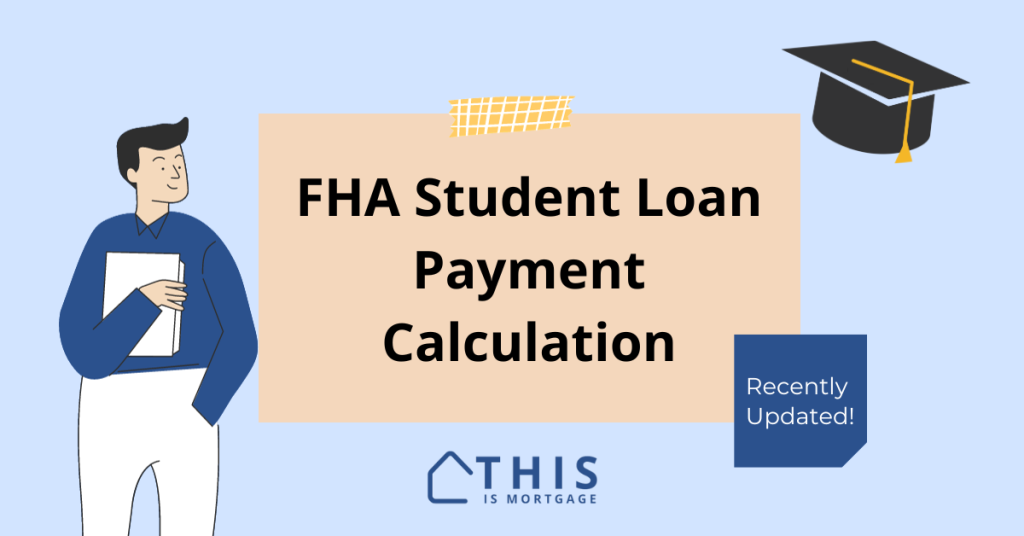FHA student loan rules 2024: FHA now uses 0.50% of the loan balance for income-based or deferred student loans where the payment is $0. This replaces the old rule of 1.0%.
These guidelines could help you qualify for a $25,000 higher home price based on the current student loan balance average.
See if enhanced student loan rules can help you qualify.
Summary of FHA student loan changes
In 2021, FHA changed its rules about how lenders calculate student loan payments into debt-to-income (DTI) ratios. The new rules are as follows.
Student loan payments where a payment above $0 is available
- The payment as reported on the credit report
- The payment as reported on other documentation such as a loan statement
Student loan payments where the payment is $0 or no payment information is available
- Payment is calculated at 0.5% of the outstanding loan balance
Note that even if your payment is $0 in an income-based plan, the lender still must use 0.5% of the loan balance.
Pre-2021 Guidelines
Prior to August 2021, FHA applicants had to qualify using 1% of the balance for deferred or reduced payment plans. (Prior to 2016, that figure was 2%).
Example: Favorable payment calculations could get you approved
Here’s how recent changes could help you be approved for a mortgage.
| Prior to Aug 2021 | After Aug 2021 | |
| Student loan balance | $100,000 | $100,000 |
| Deferred payment | $0 | $0 |
| Qualifying payment | $1,000 | $500 |
| Total housing + debt payments | $4,000 | $3,500 |
| Monthly Income | $8,000 | $8,000 |
| Total debt-to-income ratio | 50% | 44% |
| Approved? | No | Yes |
Assuming a reasonably strong file, this applicant would likely be approved at a 44% debt-to-income ratio. While 50% is possible with FHA, it’s not as likely.
Speak to a lender to see if you can be approved to buy a home.
The average college graduate gained $25,000 in buying power
The average college graduate has $34,100 in debt after four years of college.
For those with deferred or income-based student loan payments, new FHA rules could mean a big difference in what they can qualify for.
Under old rules, the lender would have to assume a payment of $341 per month for the average college grad if no payment information were available.
Now, the lender could assume a $170-per-month payment for the average student loan holder.
| Old rules | New rules | |
| Maximum house payment | $2,530 | $2,700 |
| Maximum home price | $300,000 | $325,000 |
The average college graduate received an increase in affordability of about $25,000, thanks to new FHA rules. But the buying power boost is much bigger for those with larger student loans.
Deferred student loan payment calculation for mortgage
As mentioned, deferred student loans often show a payment of $0 on the credit report.
What’s more, it’s hard to pinpoint what the payment will be when payments begin.
That’s why FHA came out with new rules stating the lender can use 0.5% of the outstanding loan balance to use in the applicant’s debt-to-income ratio calculation.
Connect with a lender to check your homebuying eligibility.
FHA IBR student loan calculation for mortgage
FHA applicants on income-based repayment (IBR) plans can use the payment as stated on the credit report, even if that payment doesn’t fully pay off the loan during the loan term.
If the credit report states a $0 payment, the lender will use 0.5% of the loan balance to qualify, unless you have documentation proving a lower payment.
Student loans formerly paused due to COVID-19
Certain student loan payments were paused until October 2023. If your credit report still shows a $0 payment, or no information is available, the lender will use 0.5% of the loan balance.
Student loans showing the full payment
The lender will use the full payment shown on the credit report. If that’s more than 0.5% of the loan balance, the lender still must use the full payment amount. If the higher amount keeps you from qualifying, look into an income-based repayment plan. This could reduce the required payment enough to qualify for a larger mortgage.
Loans where no payment information is available
If the credit report simply doesn’t report a payment at all, then the lender will use 0.5% of the loan balance for qualifying purposes.
How do conventional loans calculate student loan payments?
Lenders will use the following calculation for student loan payments for conventional loans.
- The amount shown on the credit report
- If the credit report is inaccurate, the lender will use the payment from the most recent loan statement
$0 payment or no payment information shown on the credit report
- If on an IBR plan
- The lender can accept documentation that the payment is in fact $0 and use that in DTI calculations
- If a deferred loan or a loan in forbearance
- 1% of the outstanding loan balance, even if it’s lower than the actual payment, or
- The actual payment on loan documentation
Check your conventional loan eligibility. Find a lender here.
USDA mortgage student loan calculation
USDA matches FHA guidelines for payment calculations.
Student loan payments where a payment above $0 is available:
- The payment as reported on the credit report
- The payment as reported on other documentation such as a loan statement
Student loan payments where the payment is $0 or no payment information is available
- Payment is calculated at 0.5% of the outstanding loan balance
All student loans, whether deferred or in a forgiveness plan must be calculated in DTI ratios until the lender fully releases the debt.
VA home loan student loan calculation
A student loan that is deferred for more than 12 months after the closing date of the mortgage does not have to be included in DTI ratios for VA loans.
Lenders must calculate VA student loan payments for all loans with payments due within 12 months of closing as follows.
- 5% of the outstanding balance divided by 12
- Ex. $20,000 in student loans x 5% is $1,000, divided by 12 is $83 per month.
- If the actual payment is greater than this calculation, the lender must use the larger amount
- If the actual payment is less, supply a student loan statement dated within 60 days of closing
Favorable student loan calculations can make you a homeowner
No matter which type of loan you’re planning to get, check all your options. Another loan type may be more favorable for deferred or IBR student loans.
In some cases, a small guideline difference could give you a mortgage approval and make you a homeowner.




